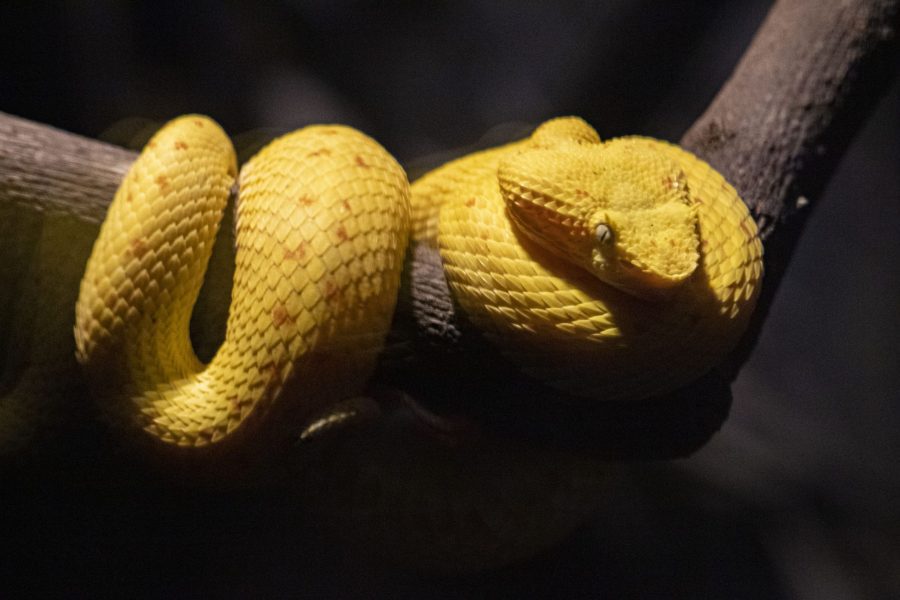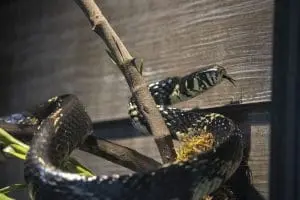

Our Venom House habitats are carefully designed to simulate its residents’ natural environments!
Happy World Snake Day! It may be hovering around 90 degrees most days here at the Zoo, but inside our Venom House habitats, it’s a cooler 80 degrees with a chance of rain (from misters!).
These habitats are bioactive systems, or self-sustaining biomes based on the animal’s native environment. This replicates the ecosystem our resident snakes and poison dart frogs would find in a natural rainforest ecosystem.
This effort started from the ground up – literally.
Pea gravel and fine mesh began the process by providing drainage. Dirt was next – special dirt that our Herps and Aquatics team makes themselves! A mix of several mosses along with coconut husk, different bark structures and dirt helps the soil be as nutrient rich as possible and creates aeration, said Mack Ralbovsky, the area supervisor of the Herps and Aquatics team.
You may not spot them, but insects like springtails have been added to help increase nutrients to the soil and provide a food source for our poison dart frogs. They’re also beneficial to the living plants in the habitat. These plants are carefully cared for by the Herps and Aquatics team as well.
Leaf litter similar to what you would find in a rainforest ecosystem covers the ground, giving the frogs a way to forage and hide.
 From there, freshly cut grape vine and different perching options were added. Most of the snakes are arboreal like the emerald tree boa and eyelash vipers – or semi-arboreal, like the tiger rat snakes and yellow-bellied puffing snake. All the perching receives fresh moss and different joints to simulate as natural a setting as possible.
From there, freshly cut grape vine and different perching options were added. Most of the snakes are arboreal like the emerald tree boa and eyelash vipers – or semi-arboreal, like the tiger rat snakes and yellow-bellied puffing snake. All the perching receives fresh moss and different joints to simulate as natural a setting as possible.
This mini ecosystem is carefully monitored with Bluetooth temperature probes and humidity gauges to ensure it fits the parameters of a South American rainforest ecosystem. These monitoring devices, along with the ability to change the amount of UV exposure our animal residents receive, allow our keepers to even simulate the seasons!
This attention to detail doesn’t just extend to their habitat. Our keepers are always thinking up ways to enrich our animal residents’ day-to-day.
For our Venom House residents, the enrichment can include adding the scent of a prey item to a branch just before dinnertime.
Our animal care team will provide different places for our snakes to rest or hide in, like a special box for our tree rat snakes. They have even epoxied hollowed-out gourds for residents like our puffing snake and tree boa to sit in a pool of water inside.
“Enrichment has been a key thing to see positive welfare improvement to the snakes,” Mack said.
All these changes we’ve made are backed up by the latest scientific research on caring for snakes and amphibians – along with our own observations on the welfare of our Venom House snakes. Our team looks to see if our snakes are eating and drinking well, look comfortable throughout the habitat, have a normal shed cycle and more.
“At Brevard Zoo, we strive to give the best quality care for the animals and always look to improve their welfare,” Mack said. “We take care of them 24/7, so it is our goal and our responsibility to give them the best quality care and simulate their natural range and habitat.”
Next time you peek into our Venom House, see if you can note some of the changes we have made!
Brevard Zoo is an independent, not-for-profit organization that receives no recurring government funding for our operating costs. Your generous support enables us to continue to serve our community and continue our vital animal wellness, education and conservation programs.
